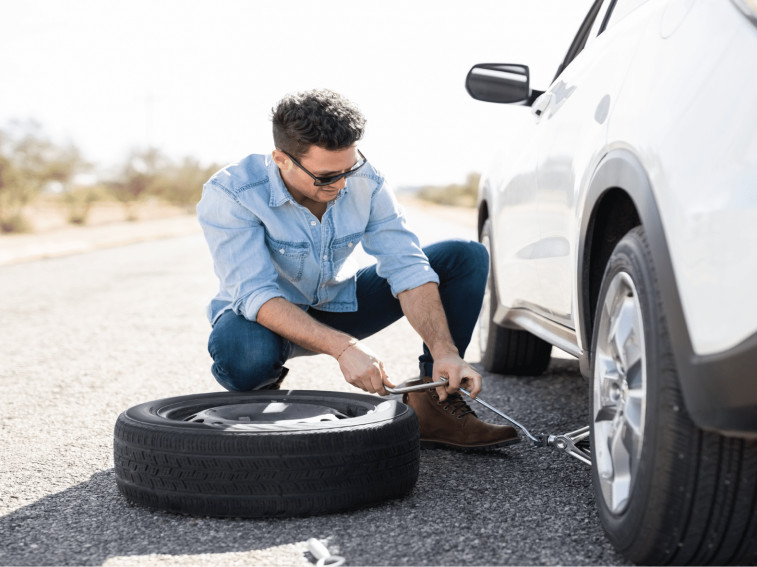While tyres are generally very robust, they are susceptible to damage from sharp objects and potholes because they’re made of rubber. And while it’s a good idea to try your best to avoid having any encounters with sharp objects and potholes if you can, sometimes these experiences are inevitable and unfortunately lead to flat tyres.
At best a flat tyre will be an inconvenience and a time delay, and at worst it can cost a significant amount of money. Getting a flat tyre for the first time can also be a frightening experience, especially if you’re far from home, alone or driving at night. And we understand that, so to make this experience less stressful, we’ve put together this guide on how to change a flat tyre for beginners, to help inform you of what to do and what you’ll need if you ever find yourself in the situation.
Step 1: Remain calm and assess the situation
First things first, always assess the situation you are in and make a judgment call on whether it’s safe to change the tyre. You should never attempt to change a tyre if it compromises your personal safety. An example of this is if changing the tyre requires you to have your back to oncoming traffic, or if it’s late at night and you’re in an unfamiliar area without a lot of light. In these scenarios, it’s almost always best to not attempt the change. Call a family member or friend to let them know what’s happened and then inform your breakdown cover/breakdown service.
Step 2: Pull up somewhere safe and gather what you need
It’s better to drive further and damage your wheel rims than to try and pull over in a dangerous area, such as a narrow or winding road. As soon as you find somewhere safe to park your car, immediately put your hazards on to alert oncoming drivers of your presence. After that, grab your car’s manual and exit the vehicle. All passengers should stand behind road barriers if they are present.
Essential tools you need to change the tyre
- A new wheel/tyre - This tyre needs to be fully inflated. It’s advisable to check your spare tyre's pressure occasionally to make sure it’s up to regulation.
- A wrench - (preferable a wheel wrench for easy leverage) To remove the wheel nuts. Car jack - This is to lift the car off the ground so you can remove the tyre.
- A wheel chock or brick - Wheel chocks stop the car rolling forward when jacked up.
- A torch or your phone - You can use this for light if you’re changing the tyre at night or it’s overcast out.
Extra tools that would be great to have on hand
- Gloves - Just in case you need extra grip or if your wheel is dirty.
- Hi-vis jacket - A high-vis jacket will make you more visible to other drivers.
- A flat surface like a piece of wood - Any flat piece of wood will be able to give the car jack a stable surface.
- Tyre pressure gauge - It’s important to check the pressure of your new tyre.
Step 4: Positioning the wheel chock
After you have assembled all the necessary equipment, go ahead and position the wheel chock. To position the wheel chock (or brick) correctly place it on the opposite wheel from the one that has the flat. For example, if the puncture is on the back left wheel, place the chock on the back right wheel. If you have more than one, it’s best to position chocks in front of all wheels.
Step 5: Loosen the wheel nuts
Now the car is steady and secure, it’s time to get to work removing the wheel. It’s safest to remove the wheel nuts while your flat tyre is still on the ground. If you find the wheel trim is getting in the way, then just pry it off. Secure the wrench to the first wheel nut and turn it anti-clockwise.
Always use your body weight to push down on the wrench with the flat of your hand. Using a closed fist can be dangerous if you slip as you can end up punching the ground and hurting your hand. Loosen the nut to the point where it can be turned by hand, but don’t completely remove it just yet. This can be a difficult task so don’t be discouraged if you don’t get it the first time!
Step 6: Jack the car up
Generally speaking, it’s best to position the jack at the side of your car close to the punctured wheel. However, your car handbook will tell you the specific jacking points of your car. It’s best not to simply guess because every car is different. Placing the small plank of wood we mentioned earlier underneath, will help steady the jack by giving it an even surface to stand on. Now carefully raise your car up around 6 inches off the ground. Never put any part of your body under the car once it is raised off the ground.
Step 7: Remove the old tyre and mount the new one
Now is the safest time to remove the wheel nuts from Step 5. Once they are all off, you can start gently removing the flat tyre from your car. Once you have removed the flat tyre, slide your new wheel onto the protruding bolts. It’s worth mentioning that tyres can be extremely heavy, so if you have passengers, ask one of them to help you lift and align the new wheel. After you have the new wheel on the bolts, place the wheel nuts back into position and screw them on by hand.
Step 8: Lower your car back onto the ground
Slowly lower your car down slightly so the new wheel is just touching the ground. Once your car is lowered, take the wrench and secure the wheel nuts, making sure to fully tighten. When you are confident that the bolts are fully secure, you can now bring the entire weight of the car back onto the ground and remove the jack.
Now you can take away the chocks, jack and old tyre and store them in the boot of your car. Give the wheels nuts one last tighten for good measure before getting back in the car. And that’s it - you have successfully changed your first tyre!
Even though the tyre has been replaced and you are on the road again, visiting a trusted garage at the first opportunity is a top priority. A mechanic will be able to assess your flat tyre and decide whether it can be repaired - which is much cheaper than buying a new one. If it cannot be repaired and it has to be replaced, it’s best to take care of it sooner rather than later.
Now you’ve had a crash course in how to change a tyre on a car, you can feel more confident on the road. It’s best to keep the necessary tyre changing kit in your car at all times just in case of an emergency.
However, if your car is unreliable and this flat tyre is the final straw for you, we have plenty of great deals on salvaged and seized vehicles for you to explore. Similarly, if many of your car’s parts are working just fine, you could put it up for auction with us in our salvage car auction and use the profits to buy yourself a newer, more trustworthy vehicle.
We have long been a leading figure in the world of online car auctions and pride ourselves on only providing the very best service to our customers. Our extensive range of cars includes leading manufacturers: Mercedes, Peugeot, Audi and more. Why not take a look around, and see what you can find?




